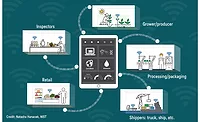Create an IoT Infrastructure to Follow Your Food Through the Supply Chain

Tracking food through the supply chain used to be simple. Farmers would harvest the food from their fields, put it on a truck and transport it to their local market to be sold directly to end users. Under such an arrangement, farmers could easily vouch for the quality of their food because it had been in their possession throughout the process.
As farming has become more automated and factory farms are the dominant food producers, the food supply chain has stretched farther away from the fields than ever before. Knowing where food has come from and where it needs to go next is much more complex now, and food engineers need new technologies to ensure they understand where their inventory, materials and byproducts are throughout the transportation process.
That’s where Internet of Things (IoT) technologies come into the picture. The IoT, comprising multiple highly developed technologies, allows food producers to understand at a granular level where their products are at all times. Building a sophisticated IoT infrastructure often starts with incorporating radio-frequency identification (RFID) tags and readers into a food production operation.
Once RFID technologies are in place, food producers can start making decisions about what other IoT technologies might be useful in helping them build supply chain transparency. A comprehensive system can allow them to run their businesses more efficiently and effectively than competitors.
Why RFID Is the Crucial Starting Point
RFID technology may seem simple on the surface. After all, you can purchase a roll of RFID tags from Amazon and put them on the assets you want to track, but without the proper tracking infrastructure they are useless. That’s why it’s important to consult with experts in the field to build the appropriate data capture and analysis infrastructure to make the system complete.
There must be a robust software component recording the data and an expert team whose sole job is to take the data and interpret it. Partnering with an effective implementation company will provide you with the bandwidth to use the system effectively and integrate the information into your enterprise-wide management system.
Using this system, food engineers can keep track of products from the time they leave the field through production and all the way into customers’ pantries or refrigerators. Having this information at your fingertips will help streamline the process and can lower spoilage costs along the way.
What RFID Could Mean to Your Operation
A properly structured RFID system will offer you more information about your products than ever before. You will know precisely how much product comes into your facility, how and when it is processed, and determine whether it followed all the proper protocols so you can vouch for its authenticity throughout the supply chain. For some food items, being able to provide assurances that the food is exactly what it says on the package is critical.
If someone has a nut allergy, for example, a product labeled “nut free” must be able to be traced all the way back to the production facility and prove it is nut free. RFID tagging will allow you to know that it actually went through all the necessary steps to be certified “nut free” and that there was no cross-contamination on the production line. Conversely, if it becomes clear through RFID tracking that the product did not go through all 10 steps, the production line can be halted immediately, preventing the tainted product from reaching the allergic consumer and causing them harm.
Lastly, having the precise location of your products can be helpful in maintaining their freshness as they move through the supply chain. Employing a full tracking infrastructure will allow you to figure out how long a product has been at a specific location and, with the right software, trigger an alert if something has been in place for too long.
By availing yourself of a complete IoT solution, you will be able to implement a more accurate “first-in, first-out” (FIFO) inventory management system. You will be able to guarantee the right products are shipped to your production partners, which in turn will allow them to guarantee freshness once their products arrive in the consumers’ hands.
The Bottom Line
To implement an effective RFID system and its tracking software, you first must find the correct asset management partner to help you along the way. They should be able to help you identify which steps in your process are most critical to track and focus on building customized systems that are tailored toward allowing you to do so. In addition, the IoT solution should be repeatable and scalable so it can grow along with your company without disruption. With a complete IoT solution and the right partners, you will have greater visibility into your supply chain than ever before and can improve the efficiency and effectiveness of your facility.
Looking for a reprint of this article?
From high-res PDFs to custom plaques, order your copy today!






